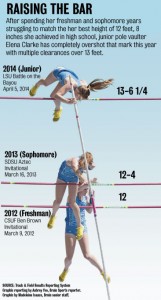Since Elena Clarke was in the eighth grade, the pole vault crossbar was always an obstacle she wanted to conquer.
By the end of her time in high school, she had already cleared an obstacle hovering a full 12 feet, 8 inches off the ground.
Now a junior on the UCLA track and field team, Clarke has established herself as one of the most reliable pole vaulters on the team, clearing her sixth straight height above 13 feet just this week.
It’s hard to imagine that it was only a year ago that she was struggling with the sport and had to face the biggest challenge of her pole vaulting career: clear 13 feet or get cut.
***
When pole vault coach Anthony Curran first recruited Clarke, he saw in her the prototypical pole vaulter – someone with a tall and lean build.
“She just needed to learn to run a bit better and take off a bit better, and things would start happening,” Curran said.
Unfortunately, Clarke was unable to live up to that potential her first two years at UCLA. She wasn’t even able to match the highest mark she cleared in high school.
After two years of watching Clarke perform below expectations, jumps coach Jack Hoyt finally had a talk with her to address these struggles.
“I thought, for her sanity and mental health, it might be wise to stop vaulting,” Hoyt said. “She wasn’t able to travel because she wasn’t clearing high enough bars. It’s no fun if you’re just practicing without getting to compete.”
But she wasn’t ready to call it quits just yet. Clarke asked for one last chance to prove that she could reach the potential that everyone saw in her.
“I loved that she was determined to do that,” Hoyt said. “It showed a lot of courage and belief in herself that she could turn her vaulting around, and she really did.”
The agreement was 13 feet by the fall.
Now, all she needed to do was find a way to make that happen over the summer.
***
On the surface level, pole vault works in the following manner: cross the bar, raise it higher, then try to cross it again.
But look into the complexities of the sport and you’ll see a myriad of intricacies that go into every vault, with every one as important as the next.
“I used to call it a continuous science experiment because you can never narrow it down to one factor that’s going to help you,” Clarke said. “In every single jump I take you have to factor in a million different things.”
Making the jump to 13 feet meant Clarke had to improve in as many areas as possible.
Instead of a relaxing, class-free schedule that many college students look forward to in the summer, Clarke’s summer itinerary was packed with a crash course in everything pole vault.
Whether it was running techniques with Hoyt, training with other pole vault coaches who lived close to her hometown or some good old strength and conditioning, Clarke did whatever it took to aim for the elusive number.
At each stop along the way was the person Clarke could always rely on for support throughout her college pole vaulting career: her best friend, senior pole vaulter Natasha Kolbo.
“We probably spent six hours a day (together). … We ran together, we lifted together, we struggled together from the very beginning,” Kolbo said. “She’s put in a lot of work and a lot of effort. I know that I can actually say that she’s one of the most dedicated people on the team, knowing that just because I’ve done so much work with her.”
By the end of the summer, Clarke returned to UCLA stronger, more technically sound and, most importantly, more confident.
“I think the combination of working with a few different people in the summer to get a few different ideas was good, and I encourage that with a lot of my vaulters,” Curran said. “When she got back here, she was just dialed in, and it was a matter of her trying to convert everything she learned in the summer and worked on in the fall to start jumping high again.”
In Flagstaff, Ariz., at the first meet of the season, it was time for Clarke to see if all that hard work was enough.
***
The crossbar now stood at a height of 13 feet, 4 1/4 inches as Elena Clarke stood on the opposite end of the runway, ready to make her approach. 
It was an unfamiliar feeling for the pole vaulter, whose best jump just the year before measured at 12 feet, 4 inches.
The feeling of crossing that height was an even stranger one.
“In the past, I’ll not sleep before a meet because I’m nervous, but I literally lay awake that entire night after the meet just so confused that I’d actually jumped 13 (feet), 4 (1/4 inches),” Clarke said. “At first, I didn’t really believe it and it’s still in a way weird that I’m succeeding as much as I am, but it feels really good.”
But as the year went by, meet after meet that feeling became less and less foreign to Clarke. She didn’t just became a reliable pole vaulter in competitions – she became an inspiration.
“She wasn’t a senior and I said, ‘You’re training and competing like a team captain, so I’m going to consider you a team captain,'” Curran said.
As Clarke began to process the entire journey of fighting to stay on the team, striving to make improvements throughout the summer and getting appointed to a new leadership position, her coach noticed the pole vaulter break into a smile.
Going forward, 13 feet will not look menacing to Clarke anymore.
